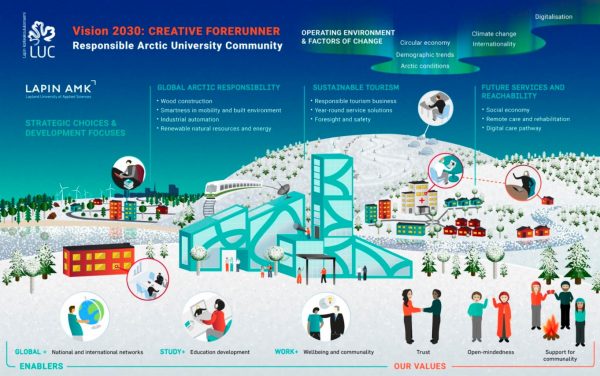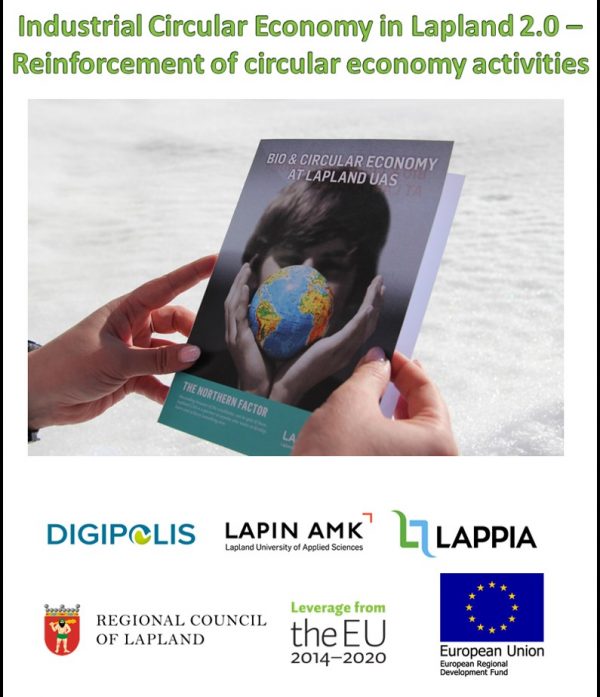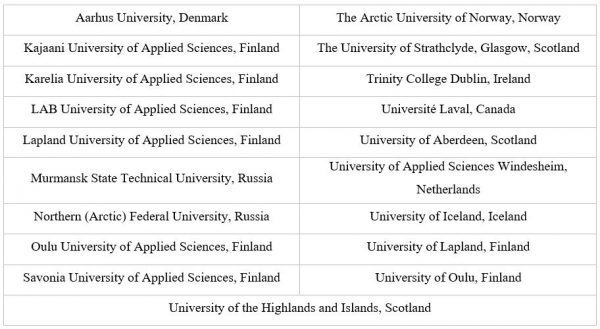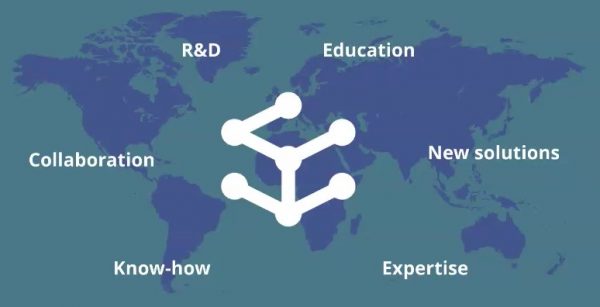Sanna Tyni, Ph.D., Principal Lecturer, The School of Arctic Natural Resources and Economy, Lapland University of Applied Sciences
Abstract
The University of the Arctic (UArctic) accepted a new thematic Network of Circular Economy (UArctic TNCE) among its extensive list of networks in May 2021. The network of Circular Economy is hosted by Lapland University of Applied Sciences (Lapland UAS) and contains 19 member organisations across the world. Challenges involved in the circular economy usually require a multidisciplinary expertise. The overall goal of the UArctic TNCE is therefore to enhance networking and the exchange of knowledge among experts of various disciplines on a national and international level. Cooperation between universities and scientific organisations will provide an opportunity to learn from the specific features of each Arctic area.
Arctic areas, as intrinsically challenging operating areas, require a knowledge of Arctic conditions and the impacts of long distances on activities. There have already been discussions about what possibilities the circular economy’s economic perspective offers people in Arctic areas. The UArctic TNCE is at the beginning of its journey to increase the awareness of the circular economy and its connection with sustainable development at the global level. This article presents the background of the UArctic and its thematic network, as well as the main objectives of the UArctic TNCE.
The University of the Arctic – UArctic
The University of the Arctic (UArctic) is a global network of universities, colleges, research institutions, and other organisations which share the desire of building and strengthening educational and research collaboration in Arctic areas. The network was created by the Arctic Council, and its members are from North America, Europe, Russia, and Asia. The network follows the United Nations Sustainable Development Goals (UN SDG, 2021), and the aim is to “enhance human capacity in the North, promote viable communities and sustainable economies, and forge global partnerships”, as the UArctic webpages state (2021). The values of the UArctic are: Circumpolar, Inclusive, Respectful, Collaborative, Open, and Influential (UArctic, 2021).
The UArctic Strategic Plan 2030 presents the challenges familiar to all of us working and living in Arctic areas. Although only a fraction of the world’s population lives in Arctic areas, the areas’ natural resources such as energy, minerals, freshwater, fish, and nature constitute 20% of the world’s total resources (UArctic Strategy, 2021). “The Arctic region shares many common features, but [it] is also one of great diversity”, as the UArctic Strategic Plan 2030 states (2021). The UArctic works through the collaboration of its member institutions. The aim is to bring the knowledge, diversity, and experiences of its members together to foster international collaboration between educational and R&D institutions. The member institutions form Thematic Networks with various themes, and these networks are grouped under the categories of “Business, Politics, & Law”, “Culture & Social Sciences”, “Engineering & Technology”, “Health & Education”, “Humanities & Arts”, “Natural Sciences”, and “UArctic Institutes”. These networks are independent, self-organising, and plan development activities among the network’s member institutions. The goal is to enhance collaboration between the organisations, and develop education and R&D activities. The actions are implemented by the principles and values of the UArctic (UArctic TN, 2021a; UArctic TN, 2021b).
The background of the thematic network preparation
Since 2017, Lapland University of Applied Sciences (LaplandUAS) has been developing the circular economy and its integration with the organisation’s R&D and educational activities. The development of the circular economy is also part of the Lapland University Consortium (LUC) strategy – Vision 2030 (LUC Strategy, 2020). LUC will operate as a community in an ecologically, socially, and economically sustainable way. The circular economy is one of the themes of the operating environments and factors of change (Figure 1). The strategy is divided into three sections, which all share the principles of sustainable development in the Arctic environment (LUC Strategy, 2020).

Figure 1. The Vision 2030: Creative Forerunner. An illustration of LUC Strategy 2030 (© LUC).
In the development work’s early stages, it was clearly shown that the circular economy must be integrated in the different fields of research and education due to the broad nature of the theme. For example, in the education sector, every field has its own perspective of the integration of the circular economy with the specific themes. The bio- and circular economy underline the circularity in the systems. Ways of improving systems and making them more sustainable are linked, e.g. to reusability, recycling, redesigning, and remanufacturing. The transfer to activities associated with the circular economy requires an educated workforce that can utilise its knowledge in implementing circular economy principles in its work (Kantanen & Tyni, 2020; Lapland UAS CE, 2021; Sitra, 2021).
In 2020, Lapland UAS continued the promotion of the circular economy in the region of Lapland through the “Industrial Circular Economy in Lapland 2.0 – Reinforcement of circular economy activities” project (LTKT2.0). The project is being implemented with Kemi Digipolis Ltd and Vocational College Lappia between 1 June 2020 and 31 March 2023. The project is funded by the Regional Council of Lapland, the European Regional Development Fund, and Leverage from the EU 2014–2020 (Figure 2). The project’s total budget is €1,864,282 (ERDF budget: €1,491,423), which makes it one of the largest circular economy ERDF development projects in the Lapland region. The project aims to strengthen the competitiveness of the Lapland region’s companies in the transition to more sustainable action through the principles of the circular economy. The project supports companies’ innovation work by accelerating the development cycles of innovations, from research data to pilots and business. Alongside this, the project will develop the actors’ common practices and operating models to ensure they serve the accumulation of expertise and the needs of business life (LTKT2.0, 2020, Peltoniemi & Pesonen, 2021).

Figure 2. The logos of the project partners and funding.
The collaboration between Finnish Universities of Applied Sciences started in the “CircularEconomyUAS” project (2020), which was a national development project of circular economy education and R&D activities in UASs (Haapea et al., 2020). The experiences strengthened the idea of a global collaboration to enhance circular economy activities, which was also one of the aims of the LTKT2.0 project. Lapland UAS launched the preparation of the UArctic Thematic Network of Circular Economy in the autumn of 2020.
The UArctic Thematic Network of Circular Economy
Even in the early stages of the UArctic TNCE design, the aim was to bring together experts from around the world with different kinds of expertise. The nature of the circular economy benefits multidisciplinary competence, as well as the expertise of those acting in Arctic areas. The partners of the network are from Europe, Russia, and Canada (Table 1) (Tyni, 2021a; Tyni 2021b).
Table 1. The partner universities of the UArctic TNCE.

The goal of UArctic TNCE is to enhance networking and the exchange of knowledge among experts of various disciplines at the national and international level (Tyni, 2021a; Tyni 2021b). In recent years, considerable development work has been conducted in the circular economy field. It has especially focused on the industrial sector, and on areas with large populations, short distances, a wide variety of business activities, etc. However, the transformation to the circular economy also requires an understanding of the factors behind the decisions individuals make in their daily lives (Sitra 2021).
The network will focus on developing the sustainable utilisation of natural resources and seek solutions to responsibly generate economic growth. Research, development, and education can promote the path to a better future, but the transformation also requires awareness to be raised among people around the world. The UArctic TNCE will arrange webinars, enhance circular economy education in universities, and facilitate student and staff exchange programmes. The network is at the initial stage of its work and is seeking the best ways to collaborate. The objectives for the first years is to build research projects and launch the development of circular economy education at an international level (Tyni, 2021a; Tyni 2021b).
The potential?
We are living in the middle of an era of change. Digitalisation is enabling real-time collaboration around the world, because we have open access to the newest research data, and we can educate ourselves in our living rooms. At the same time, the world is becoming increasingly divided as inequality is growing. Education and R&D institutes are fighting for equality by implementing open science and education. UArctic TNCE aims for precisely these objectives. Our network is open for collaboration around the world, and we are seeking new ways to share knowledge and enhance circular economy activities. The objectives of the UArctic TNCE are drawn together in Figure 3. Our network will collaborate in enhancing the circular economy in R&D, as well as in education. We seek new solutions to upgrade circular economy expertise worldwide and to increase the number of circular economy experts in the various scientific fields. Through our collaboration, we aim to create a worldwide community of circular economy experts who seek innovation and to share their knowledge to create a better future for us all.

Figure 3. The objectives of the UArctic TNCE presentation (Tyni, 2021b).
References
CircularEconomyUAS (2020). Circular economy competence to universities of applied sciences webpage, CircularEconomyUAS, 2020. Referred 5th of Oct. 2021 https://kiertotalousamk.turkuamk.fi/circular-economy-competence-uas/.
Haapea, P., Laasasenaho, K., Tyni, S., Rosendahl, A. (2020) Development of Circular Economy Education in Collaboration of Finnish Universities of Applied Sciences, LAB Sustainability Annual Review 2020, The publication Series of LAB University of Applied Sciences, part 20, pp. 80-88. Referred 5th of Oct. 2021 https://www.theseus.fi/bitstream/handle/10024/355283/LAB_2020_10.pdf?sequence=2&isAllowed=y.
Kantanen, M.-S. & Tyni, S. (2020). Reformed curricula: tool for providing professional growth for students, Proceedings of the 16th International CDIO Conference, hosted on-line by Chalmers University of Technology, Gothenburg, Sweden, 8-10 June 2020, Vol 2(2), pp. 2-10. Referred 4th of Oct. 2021 https://research.chalmers.se/publication/519263/file/519263_Fulltext.pdf.
Lapland UAS CE (2021) Sustainability and circular economy in Lapland UAS webpage, Lapland University of Applied Sciences, 2021. Referred 4th of Oct. 2021 https://www.lapinamk.fi/en/Who-we-are/Sustainability-and-Circular-Economy.
LTKT2.0 (2020). Industrial Circular Economy in Lapland 2.0 – Reinforcement of circular economy activities (Lapin teollinen kiertotalous 2.0 – Lapin kiertotaloustoiminnan
vahvistaminen) -project, Lapland University of Applied Sciences, 2020. Referred 4th of Oct. 2021
https://www.lapinamk.fi/en/Cooperation/RDI/Projects?RepoProject=4206000066.
LUC Strategy (2020). Who we are – Vision 2030 webpage, The Lapland University Consortium, 2020. Referred 5th of Oct. 2021 https://www.lapinamk.fi/en/Who-we-are/Strategy-2030.
Peltoniemi, J. & Pesonen, H. (2021). LTKT2.0 in Lapland and in Global Level – Reinforcement of Circular Economy Activities, Lumen – Lapland UAS Journal, Lapland University of Applied Sciences, 3, 2021. Manuscript.
Sitra (2021). The circular economy webpage, The Finnish Innovation Fund Sitra, 2021. Referred 29th of Sept. 2021 https://www.sitra.fi/en/dictionary/the-circular-economy/.
Tyni, S. (2021a). Proposal for establishing a new UArctic Thematic Network of Circular Economy, Lapland University of Applied Sciences, UArctic – The University of the Arctic, 9.4.2021. Referred 6th of Oct. 2021 https://www.uarctic.org/media/1601681/6-new-tn-proposal-circular-economy.pdf.
Tyni, S. (2021b). UArctic Thematic Network of Circular Economy, Network presentation video, Lapland University of Applied Sciences, May 2021. Referred 29th of Sept. 2021 https://drive.google.com/file/d/1nRBQH-xylyT-WGkAZqQd6BTx1_SBoHy8/view.
UArctic (2021). UArctic – University of the Arctic webpage, UArctic – The University of the Arctic, 2021. Referred 29th of Sept. 2021 https://www.uarctic.org/.
UArctic Strategy (2021). UArctic Strategic Plan 2030, UArctic – The University of the Arctic, 2021. Referred 4th of Oct. 2021 https://www.uarctic.org/media/1601313/uarctic-strategic-plan-2030_final.pdf.
UArctic TN (2021a). UArctic, Thematic Networks and Institutes webpage, UArctic – The University of the Arctic, 2021. Referred 4th of Oct. 2021 https://www.uarctic.org/organization/thematic-networks/.
UArctic TN (2021b). UArctic, How Thematic Networks Work webpage, UArctic – The University of the Arctic, 2021. Referred 4th od Oct. 2021 https://members.uarctic.org/participate/how-thematic-networks-work/.
UArctic TNCE (2021). Thematic Network on Circular Economy webpage, UArctic – The University of the Arctic, 2021. Referred 29th of Sept. 2021 https://www.uarctic.org/organization/thematic-networks/circular-economy/.
UN SDG (2021). United Nations, The 17 Goals -webpage. United Nations, 2021. Referred 4th of Oct. 2021 https://sdgs.un.org/goals.
Keywords: Arctic, circular economy, collaboration, global, network